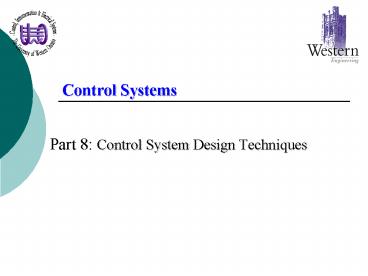Control Systems PowerPoint PPT Presentation
1 / 30
Title: Control Systems
1
Control Systems
- Part 8 Control System Design Techniques
2
Learning objectives
- To understand different control
strategies/configurations - To design controllers using root locus technique
- To state the properties and structure of lead
compensator - To state the properties and structure of lag
compensator - To design controllers using frequency response
techniques
3
Different control system configurations
(a) Cascade controller
4
Different control system configurations
(b) Feedback controller
5
Different control system configurations
(c)
(c) Cascade and feedback controller (two degree
of freedom)
6
Different control system configurations
(d)
(d) Forward and cascade controller
7
Different control system configurations
(e)
(e) Feedforward and cascade controller
8
Cascade controller design with root locus method
The original system does not have any integrator,
therefore, it will result a steady-state error
when a unit step input is applied.
Objective Design a cascade controller (in the
position of the gain K) to improve the
steady-state performance without inducing much
change to the transient behavior
9
Cascade controller design with root locus method
(Cont.)
K 164.6
Uncompensated system
10
Cascade controller design with root locus method
(Cont.)
The idea is to add an integrator to improve the
steady-state performance and also to add a zero
to cancel out the effect on the transient
behavior
11
Cascade controller design with root locus method
(Cont.)
K 158.2
Compensated system
12
Cascade controller design with root locus method
(Cont.)
Step responses of the compensated and
uncompensated systems
13
Cascade controller design with root locus method
The original system response is too slow.
14
Cascade controller design with root locus method
Uncompensated system
The design objective is to move the closed-loop
poles further to left along the constant damping
line.
15
Cascade controller design with root locus method
(Cont.)
where
K47.45
16
Cascade controller design with root locus method
(Cont.)
Compensated system
K47.45
17
Cascade controller design with root locus method
(Cont.)
Time domain responses
18
Lead and lag compensators
Lead compensator
Lag compensator
19
Frequency response of a lead compensator
20
Frequency response of a lag compensator
21
Design example with a lead compensator
Plant
Controller
-
22
Design example with a lead compensator (Cont.)
Unit step response of open-loop system
23
Design example with a lead compensator (Cont)
24
Design example with a lead compensator (Cont)
The compensator has the transfer function
The loop transfer function is then
25
Design example with a lead compensator (Cont)
Unit step response of closed-loop system
26
Design example with a lag compensator
Plant
Controller
-
27
Design example with a lag compensator (Cont)
28
Design example with a lag compensator (Cont)
The compensator has the transfer function
The loop transfer function is then
29
Design example with a lag compensator (Cont)
Uncompensated system
Compensated system
30
Summary
- Controller can interact with the system in
several different ways cascade, feedback, and
feedforward. - The essence of the controller design is to change
the dynamic characteristics of the system through
the introduction of dynamic compensator. - The compensated system should satisfy certain
criteria in s-domain (Root Locus method) or in
frequency domain (Frequency Response method). - There are two commonly used controller
structures, lead compensator, and lag
compensator.

